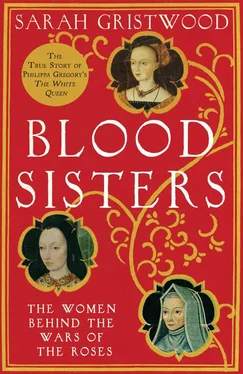Poor Anne Neville, Richard III’s wife, had been too shadowy a figure to have quarrelled with her mother-in-law. But the final woman in this story had quarrelled with half the world – Marguerite of Anjou, Henry VI’s wife, the Lancastrian queen under whose determined rule the ‘Wars of the Roses’, the Cousins’ War, had first got under way.
The events that caused the Cousins’ War, and finally brought into being the Tudor dynasty, were above all a family saga – ‘a drama in a princely house’. And the circle of women behind the conflicts and resolutions of the late fifteenth century were locked into a web of loyalty and betrayal as intimate and emotional as that of any other domestic drama, albeit that in this a kingdom was at stake.
The business of their lives was power; their sons and husbands the currency; the stark events of these times worthy of Greek tragedy. Cecily Neville had to come to terms with the fact that her son Edward IV had ordered the execution of his brother George, Duke of Clarence, and the suspicion that her other son Richard III had murdered his nephews. Elizabeth Woodville is supposed to have sent her daughters to make merry at Richard III’s court while knowing that he had murdered her sons, those same Princes in the Tower. Elizabeth of York, as the decisive battle of Bosworth unfolded, could only await the results of what would prove a fight to the death between the man some say she had incestuously loved – her uncle Richard III – and the man she would in the end marry, Henry VII.
The second half of the fifteenth century is alive with female energy, yet the lives of the last Plantagenet women remain relatively unexplored. The events of this turbulent age are usually described in terms of men, under a patriarchal assumption as easy as that which saw Margaret Beaufort give up her own blood right to the throne in favour of her son Henry; or passed the heiress Anne Neville from one royal family to the other as though she were as insentient an object as any other piece of property.
Of the seven women who form the backbone of this book, the majority have already been the subject of at least one biographical study. The aim of this work, however, is to interweave these women’s individual stories, to trace the connections between them – connections which sometimes ran counter to the allegiances established by their men – and to demonstrate the way the patterns of their lives often echoed each other. It tries to understand their daily reality: to see what these women saw and heard, read, smelt, even tasted. The bruised feel of velvet under the fingertip, or the silken muzzle of a hunting dog. The discomfort of furred ceremonial robes on a scorching day: a girl’s ability to lose herself in reading a romantic story.
The stamping feet of the ‘maid that came out of Spain’ and danced before Elizabeth of York, and the roughened hands of Mariona, the laundrywoman listed in Marguerite of Anjou’s accounts who kept the queen’s personal linen clean. The tales of Guinevere and Lancelot, popularised in these very years by a man who knew these women; along with the ideal of the virginal saints whose lives they studied so devotedly. To ignore these things and to focus too exclusively on the wild roller coaster of military and political events results in a distorted picture, stripped of the context of daily problems and pleasures.
The attempt to tell the story of these years through women is beset with difficulties, not least the patchy nature of the source material. To insist that the women were equal players with the men, on the same stage, is to run the risk of claiming more than the known facts can support. The profound difference between their ideas and those of the modern world must first be acknowledged; but so too, conversely, must recognisable emotions – Elizabeth of York’s frantic desire to find a place in the world, Margaret Beaufort’s obsessive love for her son. It is the only way we can imagine how it felt to be flung abruptly to the top of Fortune’s wheel and then back down again. And though the tactics of the battlefield are not the subject of this book, each one meant gain or loss for wives, daughters and mothers whose destiny would be decided, and perhaps unthinkably altered, in an arena they were not allowed even to enter.
The Tudor wives of only a few decades later have a much higher profile, and yet the stories of these earlier figures are even more dramatic. These women should be a legend, a byword. Perhaps their time is coming. The months between hardback and paperback publication of this book have seen the first distant rumbles of change – word that Philippa Gregory’s novels about the women of the Cousins’ War are to become a BBC series, and the furore of interest surrounding the question of whether the bones unearthed in a Leicester car park would prove to be those of Richard III. It seems appropriate that the answer could come through the strain of mitochondrial DNA passed down only in the female line, from Richard’s mother Cecily.
In a time not only of terror but of opportunity, the actions of the women forged in this furnace would ultimately prove to matter as much as the battlefields on which cousin fought cousin. 2Their alliances and ambitions helped get a new world under way. They were the mothers and midwives if not actually of modern England, then certainly of the Tudor dynasty.
PART ONE
O peers of England, shameful is this league,
Fatal this marriage, cancelling your fame
Henry VI Part 2, 1.1
It was no way for a queen to enter her new country, unceremoniously carried ashore as though she were a piece of baggage – least of all a queen who planned to make her mark. The Cock John , the ship that brought Marguerite of Anjou across the Channel, had been blown off course and so battered by storms as to have lost both its masts. She arrived, as her new husband Henry VI put it in a letter, ‘sick of ye labour and indisposition of ye sea’. Small wonder that the Marquess of Suffolk, the English peer sent to escort her, had to carry the seasick fifteen-year-old ashore. 1The people of Portchester in Hampshire, trying gallantly to provide a royal welcome, had heaped carpets on the beach where the chilly April waves clawed and rattled at the pebbles, but Marguerite’s first shaky steps on English soil took her no further than a nearby cottage, where she fainted. From there she was carried to a local convent to be cared for.
This would be the woman whom Shakespeare, in Henry VI Part 3 , famously dubbed the ‘she-wolf’ of France, her ‘tiger’s heart wrapped in a woman’s hide’. The Italian-born chronicler Polydore Vergil, 2by contrast, would look back on her as ‘imbued with a high courage above the nature of her sex … a woman of sufficient forecast, very desirous of renown, full of policy, counsel, comely behaviour, and all manly qualities’. But then Vergil was writing for the Tudor monarch Henry VII, sprung of Lancastrian stock, and he would naturally wish to praise the wife of the last Lancastrian king, the woman who had fought so hard for the Lancastrian cause. Few queens of England have so divided opinion; few have suffered more from the propaganda of their enemies.
Marguerite of Anjou was niece by marriage to the French king Charles VII, her own father, René, having been described as a man of many crowns but no kingdoms. He claimed the thrones of Naples, Sicily, Jerusalem and Hungary as well as the duchy of Anjou; titles so empty, however, that early in the 1440s he had settled in France, his brother-in-law’s territory. At the beginning of 1444 the English suggested a truce in the seemingly endless conflict between France and England known as the Hundred Years War; the arrangement would be cemented by a French bride for England’s young king, Henry VI. Unwilling to commit his own daughters, Charles had proffered Marguerite. Many royal and aristocratic marriages were made to seal a peace deal with an enemy, the youthful bride a passive potential victim. But in this case, the deal-making was particularly edgy.
Читать дальше












